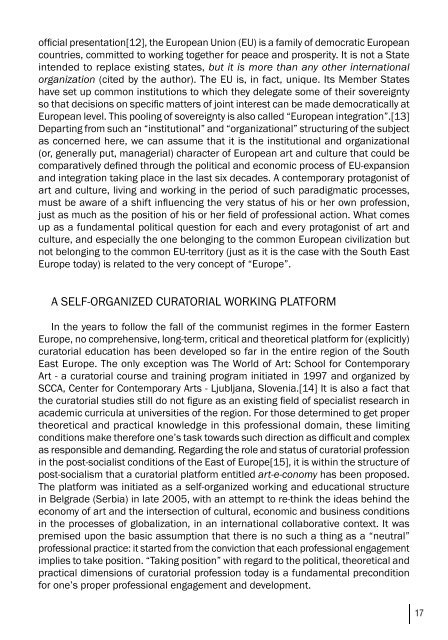art-e-conomy _ reader - marko stamenkovic
art-e-conomy _ reader - marko stamenkovic
art-e-conomy _ reader - marko stamenkovic
Create successful ePaper yourself
Turn your PDF publications into a flip-book with our unique Google optimized e-Paper software.
official presentation[12], the European Union (EU) is a family of democratic European<br />
countries, committed to working together for peace and prosperity. It is not a State<br />
intended to replace existing states, but it is more than any other international<br />
organization (cited by the author). The EU is, in fact, unique. Its Member States<br />
have set up common institutions to which they delegate some of their sovereignty<br />
so that decisions on specific matters of joint interest can be made democratically at<br />
European level. This pooling of sovereignty is also called “European integration”.[13]<br />
Dep<strong>art</strong>ing from such an “institutional” and “organizational” structuring of the subject<br />
as concerned here, we can assume that it is the institutional and organizational<br />
(or, generally put, managerial) character of European <strong>art</strong> and culture that could be<br />
comparatively defined through the political and economic process of EU-expansion<br />
and integration taking place in the last six decades. A contemporary protagonist of<br />
<strong>art</strong> and culture, living and working in the period of such paradigmatic processes,<br />
must be aware of a shift influencing the very status of his or her own profession,<br />
just as much as the position of his or her field of professional action. What comes<br />
up as a fundamental political question for each and every protagonist of <strong>art</strong> and<br />
culture, and especially the one belonging to the common European civilization but<br />
not belonging to the common EU-territory (just as it is the case with the South East<br />
Europe today) is related to the very concept of “Europe”.<br />
A SELF-ORGANIZED CURATORIAL WORKING PLATFORM<br />
In the years to follow the fall of the communist regimes in the former Eastern<br />
Europe, no comprehensive, long-term, critical and theoretical platform for (explicitly)<br />
curatorial education has been developed so far in the entire region of the South<br />
East Europe. The only exception was The World of Art: School for Contemporary<br />
Art - a curatorial course and training program initiated in 1997 and organized by<br />
SCCA, Center for Contemporary Arts - Ljubljana, Slovenia.[14] It is also a fact that<br />
the curatorial studies still do not figure as an existing field of specialist research in<br />
academic curricula at universities of the region. For those determined to get proper<br />
theoretical and practical knowledge in this professional domain, these limiting<br />
conditions make therefore one’s task towards such direction as difficult and complex<br />
as responsible and demanding. Regarding the role and status of curatorial profession<br />
in the post-socialist conditions of the East of Europe[15], it is within the structure of<br />
post-socialism that a curatorial platform entitled <strong>art</strong>-e-<strong>conomy</strong> has been proposed.<br />
The platform was initiated as a self-organized working and educational structure<br />
in Belgrade (Serbia) in late 2005, with an attempt to re-think the ideas behind the<br />
e<strong>conomy</strong> of <strong>art</strong> and the intersection of cultural, economic and business conditions<br />
in the processes of globalization, in an international collaborative context. It was<br />
premised upon the basic assumption that there is no such a thing as a “neutral”<br />
professional practice: it st<strong>art</strong>ed from the conviction that each professional engagement<br />
implies to take position. “Taking position” with regard to the political, theoretical and<br />
practical dimensions of curatorial profession today is a fundamental precondition<br />
for one’s proper professional engagement and development.<br />
17


